Your Essential Hong Bao Guide for Chinese New Year 2024
Everything you need to know about Chinese New Year Red Packets!
- The custom of giving red packets originates from some of the oldest stories of Chinese New Year. They symbolise filial piety, prosperity, good fortune and blessings.
- Previously, red packets were given and received only among families. In most places, the custom now is to give a hong bao to each child you meet during the New Year period.
- The right hong bao amount to give is subjective – set your total budget to ensure that things do not spiral out of control.
The Origin of Hong Baos
The custom of giving red packets originates from some of the oldest stories of Chinese New Year. As the legend goes, a demon named Sui came out to terrify children while they were asleep. To keep children safe from being harmed by Sui, parents would light candles and stay up for the whole night of Chinese New Year’s Eve.
According to the legend, one New Year’s Eve, a child was given eight coins to play with to keep him awake. The child wrapped the coins in red paper, opened the packet, rewrapped it, and reopened it until he was too tired to continue, and fell asleep. Then his parents placed the packet with eight coins under his pillow. When Sui tried to touch his head, the eight coins emitted a strong light and scared the demon away. The eight coins turned out to be eight fairies. Henceforth, the red packet, or ang bao, is used as a symbol to ward off evil spirits, bad luck and misfortune.
The Meaning of the Ang Paos
Chinese New Year red packets are a traditional gift for children or elderly people during the Chinese New Year. In China, the red packet money is called ya sui qian (压岁钱 yā suì qián), which means 'suppressing Sui [the demon] money'. Those who receive a red envelope are blessed with another safe and peaceful year.
Generally, on Chinese New Year’s Eve or New Year's Day, young children and grandchildren give their best wishes to their parents and grandparents. In return, grandparents and parents give their children and grandchildren red packets with money, wishing them good luck in the new year. Parents and grandparents also receive red packets from their grown-up children and grandchildren as a way of sending them good luck, happiness, and health. This embodies the value of filial piety too.
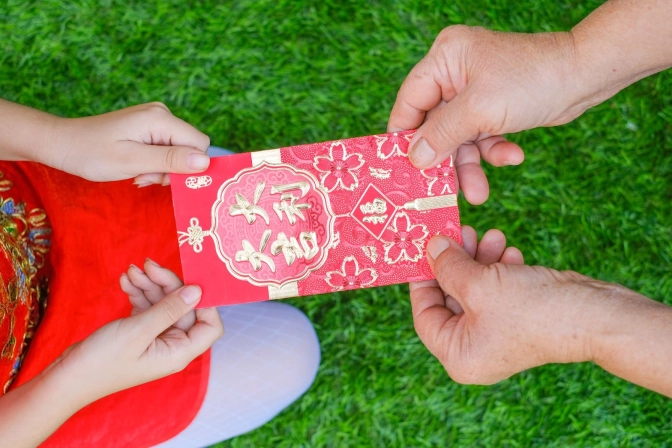
Should I Give a Hong Bao?
When is the appropriate time to start giving out red packets? Traditionally speaking, if you have started earning money, it is time to begin your experience of giving Chinese New Year hong baos. Giving a red packet is a way to share your blessings. However, there is a custom that you need not give red packets to others if you are not married.
Red packets were usually given and received only among families. In most places, the custom is to give a hong bao to each child you meet during the New Year period. However, in modern times, you can give a hong bao to anyone you have a relationship with unless they are senior to you in some way or other! Your office pantry aunty, the security guard, the delivery guy and whomever you want to wish well. After all, the true essence of hong bao giving has not changed since the old days – our relationships with one another and wish the best upon those around us.
Your close relatives (like your parents and grandparents) will keep giving you red packets even when you are married, symbolising their love and blessing.
Hong Bao Etiquette
As a general rule of thumb, one should avoid gifting cash in odd numbers as it is deemed inauspicious. Even numbers are believed to be more “wholesome” and bring stability to the receiver.
That being said, the digit “4” should be avoided (even though it is clearly an even number). When spoken in Chinese, “4” sounds like the word “death” and hence is a faux pas in Chinese culture. This means that you should avoid denominations such as $4, $14, $40, or $44 in hong baos.
Hong Bao rates usually encompass the digit “8” because it sounds like the word “fortune”, deeming an auspicious number. This symbolises well wishes for the recipient and will earn you those approving smiles and nods from older folks!
It’s also considered rude to open your Chinese New Year red packets in public, especially in front of the hong bao giver, so remember to remind your young ones about this!
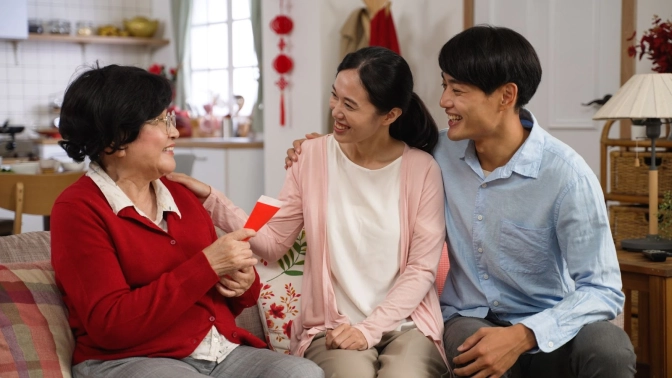
General Tips for Giving and Receiving Hong Baos
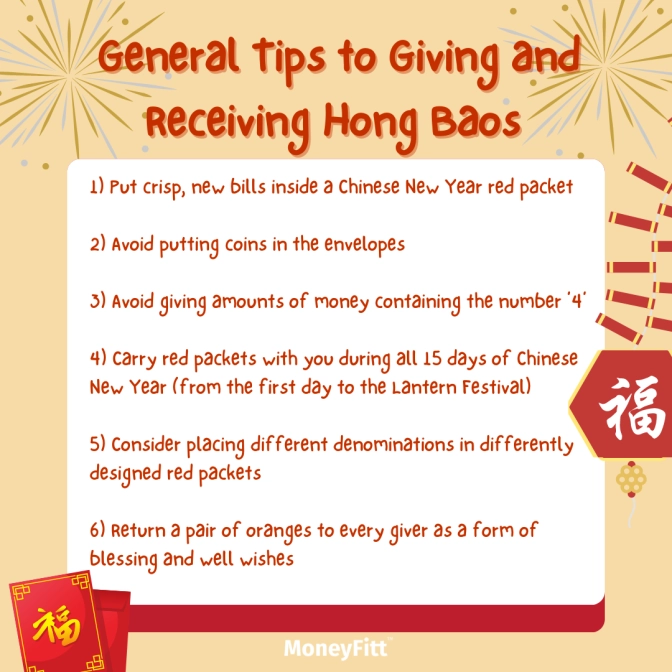
1) It is a tradition to put crisp, new bills inside a Chinese New Year red packet. Giving dirty or wrinkled bills is in bad taste.
2) Avoid putting coins in the envelopes. It is often frowned upon and not widely socially acceptable (despite the legend we shared above!)
3) Avoid giving amounts of money containing the number ‘4’. (See Ang Pao Etiquette above)
4) Prepare red packets in advance and always carry some with you during all 15 days of Chinese New Year (from the first day to the Lantern Festival) in case you bump into someone to that you may need to give one.
5) Consider placing different denominations in differently designed red packets so that you can quickly and tactfully discern whether you’re giving away $1, $10 or $100. You would not want to give away the wrong hong bao!
6) Pairs of oranges are exchanged during the Chinese New Year as they symbolise good luck and wealth in Chinese culture. You should return a pair of oranges to every giver as a form of blessing and well wishes. Build up that good karma for the new year ahead!
Recommended Hong Bao Rates
Usually, hong baos with the highest cash amounts are reserved for those closest to you (parents, spouses and other Significant Others, in-laws, and children), followed by extended family members (cousins, nephews, and nieces).
Next would be friends’ children who come to visit during the festivities, followed by co-workers, domestic helpers and any other person you fancy giving a red packet to, such as waiters, baristas and delivery riders who work hard over the festive period.
Hong baos are usually not exchanged between adult friends; instead, people will bring Chinese New Year gift sets and alcoholic beverages to house visits.
Do take heed that the following rates are simply suggested amounts; you can still give what you are financially comfortable with instead of conforming to the recommended hong bao rates.
1) Close Family (Parents, In-Laws, Spouse, Children, Siblings)
Recommended amount: $188 – 500
The largest hong baos are usually reserved for one’s parents and in-laws. They symbolise filial piety and gratitude towards them for their upbringing and support over the years. Meanwhile, hong baos for your little ones will symbolise your love and well wishes for them!
2) Extended Family (Cousins, Nephews, and Nieces)
Recommended Amount: $10 – 50
You must give your extended family members a Chinese New Year red packet each, but the hong bao rates can vary. It all depends on how close you are to that particular family member! A reasonable estimate would be one that you do not mind receiving yourself.
3) Visiting Children
Recommended Amount: $6 – 20
The hong bao rate for your friends’ or colleagues’ children can range between $6 to $8. This token sum extends your wishes for them to grow up well and have a bright future. But of course, you can give more cash of up to $20 for kids of closer friends!
4) Co-workers, Domestic Helpers, Security Guards, Cleaning Aunties
Recommended Amount: $10 – 50
Take this opportunity to show appreciation to your co-workers who hustled hard with you over the years!

Suggestions to Inflating Hong Bao Rates
As mentioned earlier, determining your hong bao rates is subjective. Here are some suggestions to help you maintain better control over your finances while still meeting your social obligations.
1. Set a Total Hong Bao Budget for the Season
Doing this will help you control your budget and minimise overspending. If you don’t have a budget in mind, try using 1% to 3% of your annual income as a starting point - you can then make further estimates from there!
2. List Your Hong Bao Recipients
Hong baos are just a way to show your care and appreciation for your family members, elders and relatives during the Chinese New Year. It is not a competition to see who gives more or less money, and thus which uncle or aunt is the worthiest.
Over time, the practice has also evolved to include individuals with whom we share casual relationships, such as children of close friends or neighbours, employees and business partners, and even your kids’ friends who come visiting.
While giving out hong baos to these latter groups is customary, the intention here is more about sharing the festive, joyful vibes. Feel free to leave them out of your list if you need to.
3. Make the Necessary Adjustments
The last step is to check that you have a sufficient budget for each group of people and make adjustments if necessary. Remember to avoid odd numbers and the number 4. Ending on an 8 is preferred, but 0, 2, and 6 are also ok.
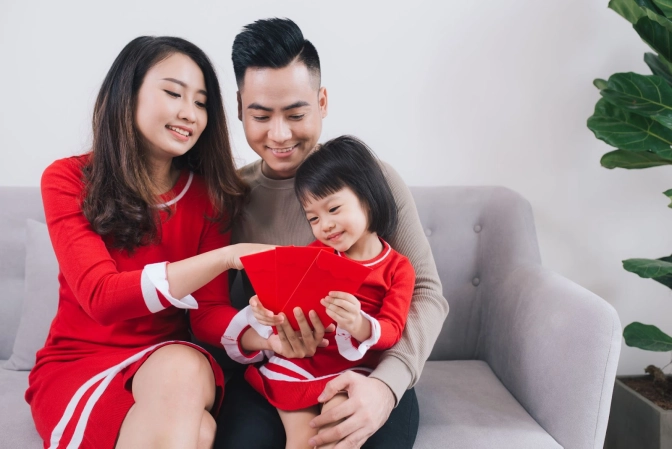
4 Alternatives to Giving Away Traditional Cash Hong Baos
Of course, if the budget is tight due to a challenging fiscal year, here are some suggested alternatives to giving traditional cash hong baos.
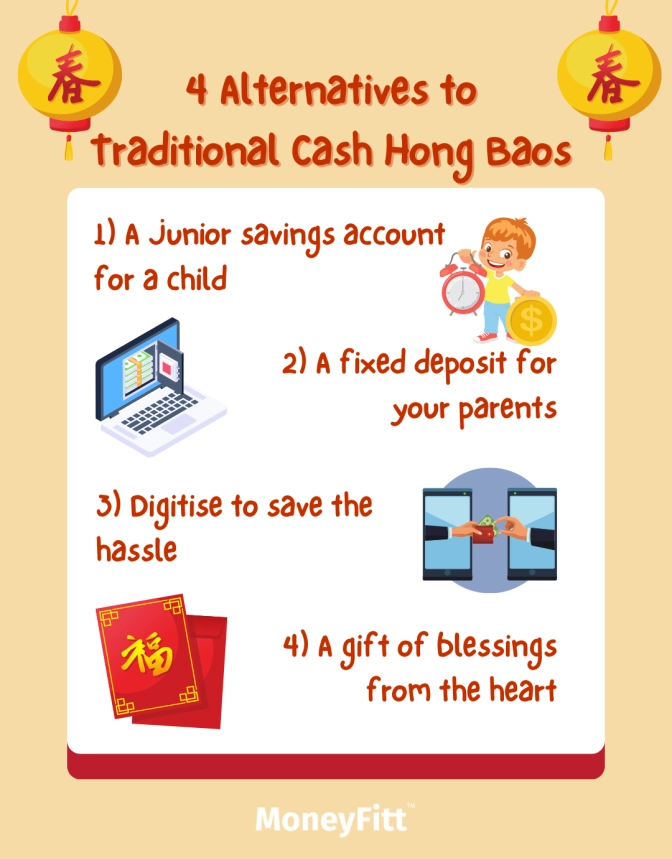
1. A Junior Savings Account for a Child
If you want to start your little one off to a good savings start – deposit their hong bao money into a junior savings account and give them the savings passbook in a red packet. If they already have a savings account – put the additional hong bao money in the bank and give them a print-out of their balance.
2. A Fixed Deposit for Your Parents
The fixed deposit can be left in the account to earn interest and provide a savings cushion for your parents (especially if they are retired) during their golden years.
3. Digitise to Save the Hassle
Many banks now provide electronic alternatives like scannable QR codes. No more queuing for change and putting notes into packets – do it the easy way.
4. A Gift of Blessings From the Heart
The act of giving a hong bao is to give the recipient blessings of luck and prosperity. Whether you do this with a modern twist or the good old-fashioned way with cash in a red packet, the intention and well-wishes remain the same.
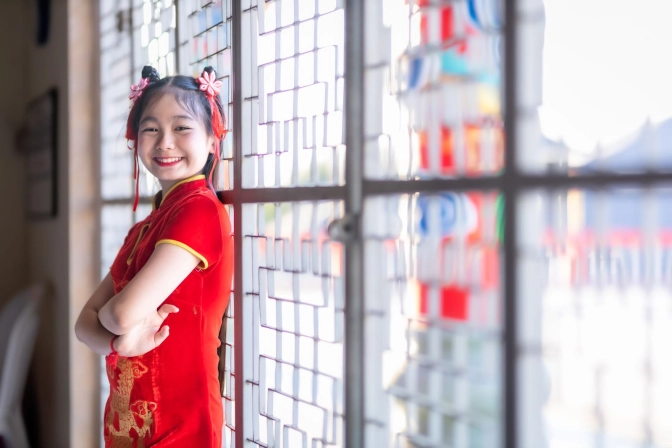
Conclusion
Hopefully, with this hong bao guide, we will be able to provide you with the support and help to have an easier time preparing your Chinese New Year red packets this year! As much as this is a convenient guide to follow, it is not set in stone. More than anything else, hong baos are symbolic gestures, and you should always give within your financial means. After all, it is the thought that counts!
With that, we hope you have a warm and wonderful Chinese New Year gathering with your loved ones in the coming year. Huat ah!
HONG BAO GUIDE FOR CHINESE NEW YEAR 2024. COMPLETED. ✅
